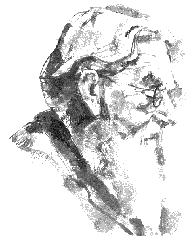D'Arcy Wentworth Thompson...on form

We are apt to think of mathematical definitions as too strict and rigid for common use, but their rigour is combined with all but endless freedom. The precise definition of an ellipse introduces us to all the ellipses in the world. The definition of a conic section enlarges our concept, and a curve of higher order all the more extends our range of freedom. By means of these large limitations, by this controlled and regulated freedom, we reach through mathematical analysis to mathematical synthesis. We discover homologies or identities which were not obvious before, and which our descriptions obscured rather than revealed, as for instance, when we learn that, however we hold our chain, or however we fire our bullet, the contour of the one or the path of the other is always mathematically homologous.
Once more, and this is the greatest gain of all, we pass quickly and easily from the mathematical concept of form in its statical aspect to form in its dynamical relations. We rise from the conception of form to an understanding of the forces which gave rise to it. And in the representation of form and in the comparison of kindred forms, we see in the one case a diagram of forces in equalibrium, and in the other case we discern the magnitude and the direction of the forces which have sufficed to convert the one form into the other.
-On Growth and Form, 1942
